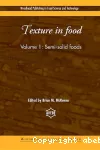Part 1 Food structure and texture
Part 1 Food structure and texture
+
-





